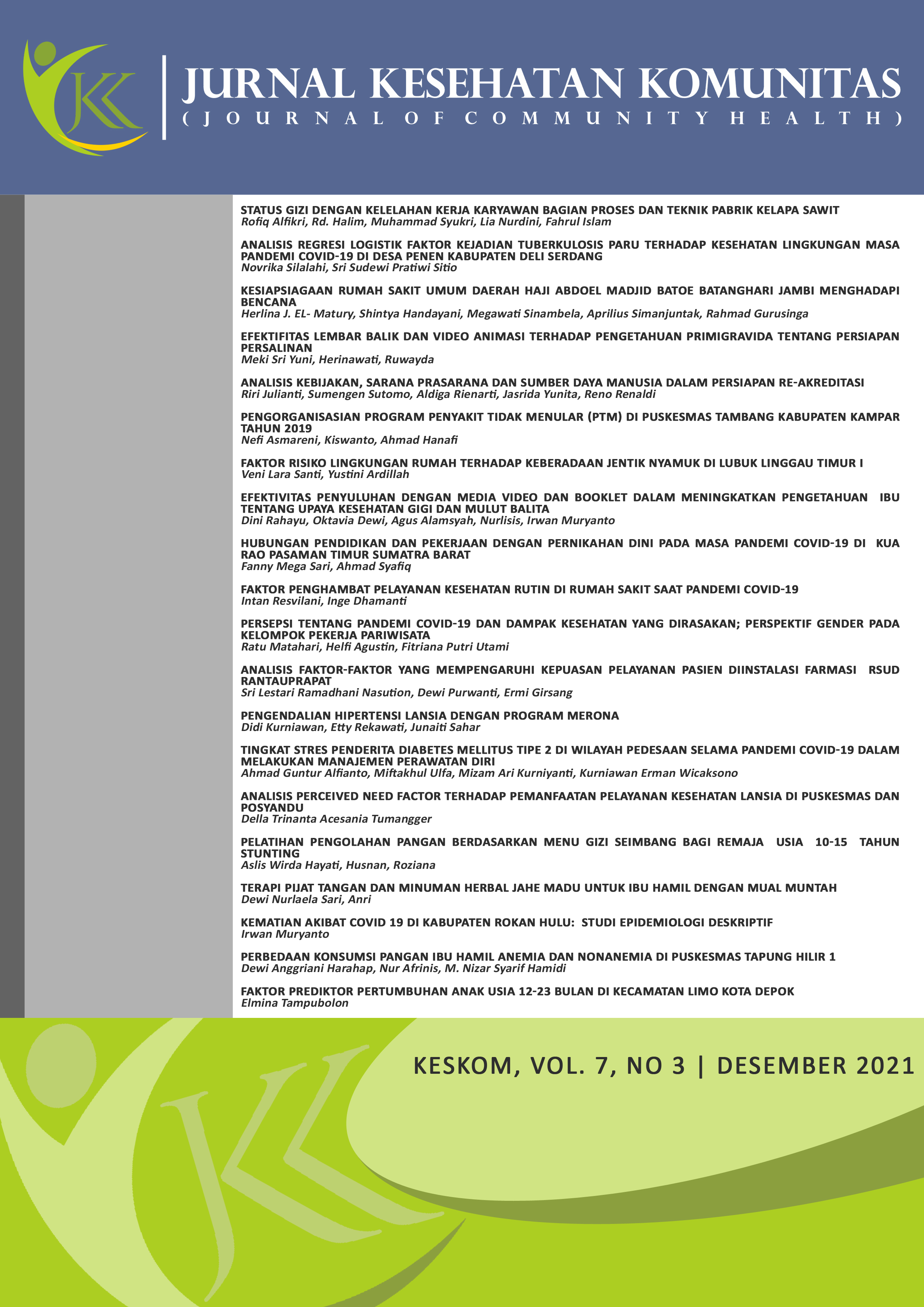Environmental Risk Factors to The Presence of House Mosquito Larvae in Lubuk Linggau East I
DOI:
https://doi.org/10.25311/keskom.Vol7.Iss3.902Abstract
Background: The existence of Aedes sp. is an indicator of the presence of a population of Aedes sp. environmental conditions also greatly affect the incidence of dengue disease, it is also related to the presence of larvae. Citra Medika Health center’s working area is a contributor of Dengue Hemorrhagic Fever (DHF) incidence with increased DHF cased from 2016-2018. Objective: to analyze the relationship between environmental conditions and the presence of Aedes sp. in the Citra Medika Health Center, Lubuk Linggau Timur District 1 in 2020. Methods: It was quantitative research with a cross-sectional design approach. The total sample was 91 respondents, who have met predetermined criteria using the purposive sampling technique, with inclusion criteria and exclusion criteria. The data used in this study are secondary data from Citra Medika Health Center and primary data obtained from interviews and direct observation. Result: It showed that there was a relationship between the implementation of Mosquito Breeding Eradication (p-value 0,047) and the presence of solid waste (p-value 0.039) with the presence of Aedes sp. larvae. Conclusion: This study concludes that the presence of Aedes sp. larvae are caused by factors such as the implementation of Mosquito breeding Eradication DBD and the presence of solid waste.
Downloads
References
Dinas Kesehatan Kota Lubuklinggau.2017. Profil Dinas Kesehatan Kota Lubuklinggau Tahun 2017. Dinas Kesehatan Sumatera Selatan : Lubuklinggau
Dinas Kesehatan Provinsi Sumatera Selatan 2017. Profil Dinas Kesehatan Sumatera Selatan Tahun 2017. Dinas Kesehatan Sumatera Selatan : Palembang
Edi Samsuar, Heru Listiono & Sutriyanti 2020. Hubungan karakteristik kontainer air bersih dengan keberdaan jentik nyamuk aedes aegypti Jurnal Ilmiah Multi Science Kesehatan, 12, 115-125.
Ferguson, N. M. 2018. Challenges and opportunities in controlling mosquito-borne infections. Nature, 559, 490-497.
Gafur, A. & Saleh, M. 2015. Hubungan tempat penampungan air dengan keberadaan jentik aedes aegypti di perumahan dinas type e desa motu kecamatan baras kabupaten mamuju utara. HIGIENE: Jurnal Kesehatan Lingkungan, 1, 92-99.
Iskandar Arfan, Ismael Saleh & Combodiana, M. 2019. Keberadaan jentik aedes sp berdasarkan karakteristik kontainer di daerah endemis dan non endemis demam berdarah dengue. Jurnal Ilmiah Ilmu Keehatan, 2, 258-266.
Kamal, S., Permana, P. P., Azmi, R. F. & Kirana, S. D. 2020. Risk factor analysis of community behavior in the eradication of mosquito nests in urban and rural areas.
Kemenkes 2017. Profil data kesehatan indonesia tahun 2016. Jakarta : Kemenrtrian Kesehatan
Marwanty, M. & Wahyono, T. Y. M. 2019. Faktor lingkungan rumah dan kejadian demam berdarah dengue di kota palopo 2016. Jurnal Epidemiologi Kesehatan Indonesia, 2.
Nurul Kholifah & Surabaya, R. 2016. Risiko penularan demam berdarah dengue (dbd) di sekolah dasar di kelurahan putat jaya, surabaya. Jurnal Ilmiah Kesehatan Husada, 05, 95-105.
Pohan, N. R., Wati, N. a. P. & Nurhadi, M. 2016. Gambaran kepadatan dan tempat potensial perkembangbiakan jentik aedes sp. Di tempat-tempat umum wilayah kerja puskesmas umbuliharjo i kota yogyakarta. Jurnal Formil ( Forum Ilmiah) Kesmas Respati, 1, 109-119.
Purnama, S. G., Susanna, D., Kardiwinata, M. P., Purnama, I. G. H. & Subrata, I. M. 2020. Knowledge, attitudes and practices towards the density of aedes larvae in a tourist destination in bali. Asian Journal of Education and Social Studies, 22-32.
Raharjanti, N. D. & Pawenang, E. T. 2018. Keberadaan jentik aedes aegypti di kelurahan karangjati. HIGEIA (Journal of Public Health Research and Development), 2, 599-611.
Saeed, Q., Ali, B., Jaleel, W., Naqqash, M. N., Sial, M. U., Ghouri, F., Ishfaq, M., Saeed, S., Jalil, H. & Hashim, M. 2017. Effectiveness of dengue fever eradication program in southern punjab, pakistan: A cross-sectional survey. J. Entomol. Zool. Stud, 5, 125-9.
Saleh, M., Aeni, S., Gafur, A. & Basri, S. 2018. Hubungan pemberantasan sarang nyamuk (psn) dengan keberadaan jentik nyamuk aedes aegypti di wilayah kerja puskesmas pancana kab. Barru. Higiene, 4, 93-98.
Sihite, E. W., Yodi, M. d. & Tri, B. 2017. Beban biaya penyakit demam berdarah dengue di rumah sakit dan puskesmas. Junal Berita Kesehatan Masyarakat, 33 (7), 357-364.
Sofia, Suhartono & Wahyuningsih, N. E. 2014. Hubungan kondisi lingkungan rumah dan perilaku keluarga dengan kejadian demam berdarah dengue di kabuiupaten aceh besar. Jurnal Kesehatan Lingkungan Indonesia, 13, 30-38.
Sulistyorini, E., Hadi, U. K. & Soviana, S. 2016. Faktor entomologi terhadap keberadaan jentik aedes sp. Pada kasus dbd tertinggi dan terendah di kota bogor. Media Kesehatan Masyarakat Indonesia, 12, 137-147.
WHO 2011. Comprehensive guidelines for prevention and control of dengue andd dengue haemorrhagic fever New Delhi : World Health Organization.
WHO 2015. Fact sheet dengue and severe dengue Online Health Statistic and Information System.
Downloads
Submitted
Accepted
Published
How to Cite
Issue
Section
License
Copyright (c) 2021 Jurnal Kesehatan Komunitas

This work is licensed under a Creative Commons Attribution-NonCommercial-ShareAlike 4.0 International License.
Copyright @2017. This is an open-access article distributed under the terms of the Creative Commons Attribution-NonCommercial-ShareAlike 4.0 International License (http://creativecommons.org/licenses/by-nc-sa/4.0/) which permits unrestricted non-commercial used, distribution and reproduction in any medium












































